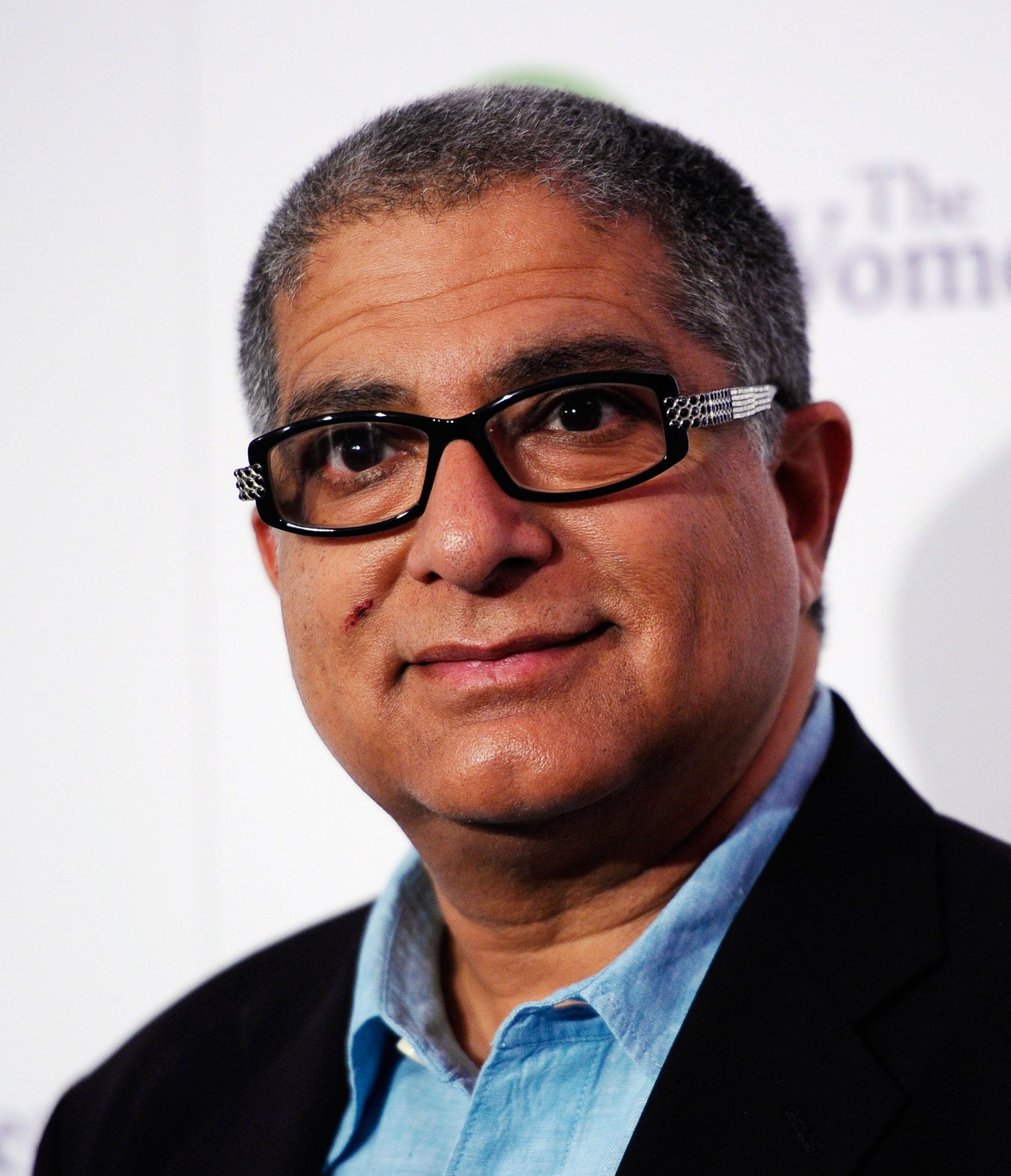The Independent's journalism is supported by our readers. When you purchase through links on our site, we may earn commission.
I'm on a higher plane! Can Deepak Chopra's new meditation app Dream Weaver help you achieve a path to Zen in just 20 minutes?
Katy Waldman turns on, iTunes in and drops out

Your support helps us to tell the story
From reproductive rights to climate change to Big Tech, The Independent is on the ground when the story is developing. Whether it's investigating the financials of Elon Musk's pro-Trump PAC or producing our latest documentary, 'The A Word', which shines a light on the American women fighting for reproductive rights, we know how important it is to parse out the facts from the messaging.
At such a critical moment in US history, we need reporters on the ground. Your donation allows us to keep sending journalists to speak to both sides of the story.
The Independent is trusted by Americans across the entire political spectrum. And unlike many other quality news outlets, we choose not to lock Americans out of our reporting and analysis with paywalls. We believe quality journalism should be available to everyone, paid for by those who can afford it.
Your support makes all the difference.Propped against my bed's headboard, I let a kaleidoscope of lights from my iPhone dance across my closed eyelids. New Age-y synths surged in my ears. I was on a vision quest for enlightenment. But it had to be a quick quest: I had plans in 40 minutes. Luckily, this particular path to Zen was timed precisely at 22 minutes, 57 seconds.
Such is the promise of Dream Weaver. A meditation app recently conceived by alternative-medicine guru Deepak Chopra, it posits that Zen might be a pitstop on the way from the pharmacy to the dog park or coffee shop. Dream Weaver (available at the App Store for £10.49) is a "light and sound programme" that uses the LED strobe on your smartphone, in conjunction with a soundtrack. The combination of soothing music, narration and psychedelic twinkling is meant to induce a trance state, entailing relaxation and, perhaps, visions; Dream Weaver's online promotional materials compare it to LSD.
The app uses brainwave entrainment, which co-creator David Mager defines in The Huffington Post as "any procedure that causes one's brainwave frequencies to synchronise with a periodic stimulus (sound, vibration or light) having a frequency corresponding to the intended brain-state".
The idea is that different frequencies of brainwaves map on to different levels of alertness: spiky beta waves are associated with hyper-vigilance; alpha waves with relaxed attention; theta waves with deep tranquillity and REM sleep; and delta waves with dreamless sleep. Dream Weaver works by flashing light at you, at lower and lower frequencies. Your anxious beta-brain supposedly follows the light down to theta-Wonderland, like Alice behind the White Rabbit. (Or maybe like a sailor waylaid by St Elmo's fire – the metaphor you use probably depends on your feelings about insta-serenity.) In any case, the testimonials are inspiring:
"I exploded into an archetypical state of releasing sadness and fear. Even now, when writing the lines of this text, my eyes get wet and I am filled with joy and compassion."
"I saw several darkly clad strangers come out of a room. I tried to offer them a message of peace telepathically. They immediately circled around me and zapped me into a state of the most joy and ecstasy I have ever felt in my life."
"I seemed to be visited by curious balls of light that just wanted to say hello."
"I was in Aruba, on vacation in Aruba!"

Methods for steering the mind into consciousness's deeper waters have existed for ages: Gregorian chanting, Native American drum circles, Hindu kirtan, Tibetan prayer bowls. But Dream Weaver marries spirituality and "science" in a way that feels peculiarly of-the-moment.
Obsessed with holistic health, many of us are willing to believe that the secret to transcendence lurks somewhere in uncharted brainwaves. The app also presents itself as a life hack, a technology for improving productivity by making us more creative and relaxed. Attain Nirvana in under 23 minutes! You'll be enlightened in time for your board meeting.
But isn't climbing the path to enlightenment supposed to be a bit harder than that? David Mager sees nothing incongruous about a digital fast-track to Zen. Dream Weaver "makes meditation accessible to more people", he says. "The notion that anyone can become an expert in anything is how we manifest ourselves in our time. When you think about spiritual practices, you used to have to follow a guru for 30, 40 years. Some people walk to the top of the mountain, and that's great, but others take the turbo-elevator."
Mager first met Deepak Chopra on a pavement in New York. The entrepreneur, who was working with companies to "green" their operations before he developed Dream Weaver, was driving down the street when he heard a woman screaming. He jumped out of his car to find her pointing at a baby bird that had fallen from its nest, which sat on a ledge 15 feet above the ground. Mager scaled the side of the building, retrieved the fledgling, and just happened to look down as Chopra exited the same building. "It was synchronicity," Mager told me on the phone. "Some things are simply meant to occur."
He explains that Dream Weaver uses Schumann resonances, the "background frequencies of planet earth": "Before there were cellphones, strobes, and incandescent bulbs, these were what you chilled with at the end of the day." The app, he says, mimics the quiet rhythms of firelight that calmed our ancestors, kindling in us a response called the flicker effect. When I ask him whether he's ever heard of a bad trip with Dream Weaver, he booms with laughter. "Bad dreams have an EEG [electroencephalography] signature of about 30Hz-40Hz. The app creates a firewall that doesn't let you get there." Incidentally, that's also why people using Dream Weaver don't drift off into sexual fantasies: the brainwave frequencies required for erotic arousal are too high.
I feared, though, that I would be incapable of having a trip at all. Past attempts to sit quietly and clear my mind have never gone well: is there anything less relaxing than monitoring how (not) relaxed you are? But Dream Weaver is designed specifically for people like me – spiritual slackers who lack the discipline to achieve Nirvana without a tech boost. Preparing to test out the app, I felt hopeful. I reclined in bed with my eyes closed and got ready to plunge into the void.
Or, more accurately, to stand in the woods. Dream Weaver has several storylines to choose from; I downloaded one called "Trip to the Forest". It includes avian chirping, a gentle rainstorm, and lots of gauzy, vaguely Eastern-sounding music. Towards the beginning, a female tour guide announces herself with loud knocking, which terrified me because I thought someone was actually banging on my door. Her job is to douse you in "anti-gravity dust" ("Don't worry, it won't stain your clothes") so you can fly to the forest; I wondered why Chopra, who narrates the rest of the trip, couldn't administer the dust himself. Throughout all this, the LED strobe drew forked golden lines on the inside of my eyelids, which was nice. But transcendent? Not really.
Since that first visit, I've journeyed to the woods several times with Dream Weaver. I have never hallucinated, or even fallen asleep, but the app usually calms me down a little. I have come to appreciate the delicate branch work of the light patterns, though I suspect they pull me somewhat out of the zone – it's hard to surrender completely to Zen with an LED strobe flashing in your face. Still! Just because my experience has been short on "darkly clad strangers" and trips to Aruba doesn't mean a more advanced meditator/haver-of-reveries wouldn't love Dream Weaver. (Perhaps if I practised, I'd get more out of it? But if I had time for that, I wouldn't need the app.)
I should note, however, that one day last week I got home feeling tired and tense. As per the Dream Weaver instructions, I secluded myself "in a dark, quiet space". I closed my eyes. I played some relaxing music. And I took a nap. It may not have been Nirvana, but it felt pretty awesome.
A version of this article appeared on Slate.com
Headspace, an app that is introducing mindfulness to the touchscreen generation, is the brainchild of former monk Andy Puddicombe and marketing executive Richard Pierson, who share a passion for meditation.
Puddicombe started his monk training at 22, before eventually being ordained at a Tibetan monastery in the Himalayas. Ten years later, he returned to the UK and, after studying for a degree in circus skills, set about demystifying meditation and making it relevant to people today. With the help of Richard Pierson, Headspace was born in 2010 and has been sharing the 3,000-year-old practice of meditation ever since.
So how does it work? First off, new users receive 10 days of 10-minute meditative sessions for free (as long as you have an iOS or Android phone, that is). These sessions are led by Andy, who talks you through letting go of the stresses of the day, with special focus on breathing and mental awareness.
The app makes relaxation and reflection easy for the modern meditator, with reminders, podcasts and random "mindfulness buzzers" that gently remind you that the worrying just isn't worth it. Altogether now: ommm…
Headspace subscriptions start at £3.74 per month for a two-year subscription. A lifetime subscription will set you back £249.85. Headspace.com
Rosie Neve
Join our commenting forum
Join thought-provoking conversations, follow other Independent readers and see their replies
Comments